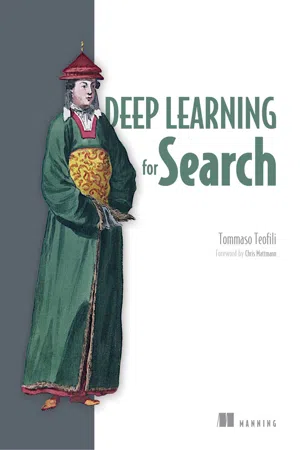
- 328 pages
- English
- ePUB (mobile friendly)
- Available on iOS & Android
Deep Learning for Search
About this book
Summary Deep Learning for Search teaches you how to improve the effectiveness of your search by implementing neural network-based techniques. By the time you're finished with the book, you'll be ready to build amazing search engines that deliver the results your users need and that get better as time goes on!Foreword by Chris Mattmann.Purchase of the print book includes a free eBook in PDF, Kindle, and ePub formats from Manning Publications. About the Technology Deep learning handles the toughest search challenges, including imprecise search terms, badly indexed data, and retrieving images with minimal metadata. And with modern tools like DL4J and TensorFlow, you can apply powerful DL techniques without a deep background in data science or natural language processing (NLP). This book will show you how. About the Book Deep Learning for Search teaches you to improve your search results with neural networks. You'll review how DL relates to search basics like indexing and ranking. Then, you'll walk through in-depth examples to upgrade your search with DL techniques using Apache Lucene and Deeplearning4j. As the book progresses, you'll explore advanced topics like searching through images, translating user queries, and designing search engines that improve as they learn! What's inside
- Accurate and relevant rankings
- Searching across languages
- Content-based image search
- Search with recommendations
About the Reader For developers comfortable with Java or a similar language and search basics. No experience with deep learning or NLP needed. About the Author Tommaso Teofili is a software engineer with a passion for open source and machine learning. As a member of the Apache Software Foundation, he contributes to a number of open source projects, ranging from topics like information retrieval (such as Lucene and Solr) to natural language processing and machine translation (including OpenNLP, Joshua, and UIMA).He currently works at Adobe, developing search and indexing infrastructure components, and researching the areas of natural language processing, information retrieval, and deep learning. He has presented search and machine learning talks at conferences including BerlinBuzzwords, International Conference on Computational Science, ApacheCon, EclipseCon, and others. You can find him on Twitter at @tteofili. Table of Contents
PART 1 - SEARCH MEETS DEEP LEARNING
- Neural search
- Generating synonyms
PART 2 - THROWING NEURAL NETS AT A SEARCH ENGINE
- From plain retrieval to text generation
- More-sensitive query suggestions
- Ranking search results with word embeddings
- Document embeddings for rankings and recommendations
PART 3 - ONE STEP BEYOND
- Searching across languages
- Content-based image search
- A peek at performance
Frequently asked questions
- Essential is ideal for learners and professionals who enjoy exploring a wide range of subjects. Access the Essential Library with 800,000+ trusted titles and best-sellers across business, personal growth, and the humanities. Includes unlimited reading time and Standard Read Aloud voice.
- Complete: Perfect for advanced learners and researchers needing full, unrestricted access. Unlock 1.4M+ books across hundreds of subjects, including academic and specialized titles. The Complete Plan also includes advanced features like Premium Read Aloud and Research Assistant.
Please note we cannot support devices running on iOS 13 and Android 7 or earlier. Learn more about using the app.
Information
Part 1. Search meets deep learning
Chapter 1. Neural search
- A gentle introduction to search fundamentals
- Important problems in search
- Why neural networks can help search engines be more effective
1This happened to me in real life.
Figure 1.1. Artificial intelligence, machine learning, and deep learning

1.1. Neural networks and deep learning
Table 1.1. Per-task requirements for neural search techniques
| Task | Minimum number of docs (range) | Chapter |
|---|---|---|
| Learning word representations | 1,000–10,000 | 2, 5 |
| Text generation | 10,000–100,000 | 3, 4 |
| Learning document representations | 1,000–10,000 | 6 |
| Machine translation | 10,000–100,000 | 7 |
| Learning image representations | 10,000–100,000 | 8 |
Figure 1.2. A deep neural network with two hidden layers

1.2. What is machine learning?
Table of contents
- Copyright
- Brief Table of Contents
- Table of Contents
- Foreword
- Preface
- Acknowledgments
- About this book
- About the author
- About the cover illustration
- Part 1. Search meets deep learning
- Part 2. Throwing neural nets at a search engine
- Part 3. One step beyond
- Index
- List of Figures
- List of Tables
- List of Listings